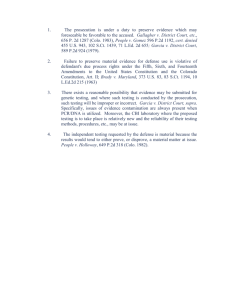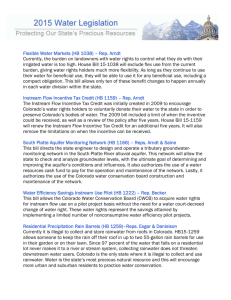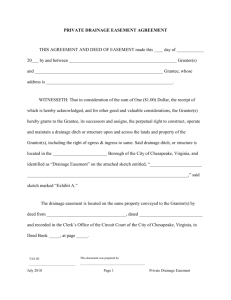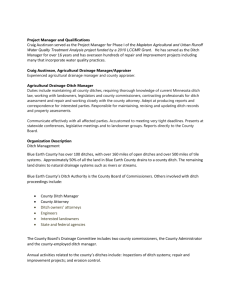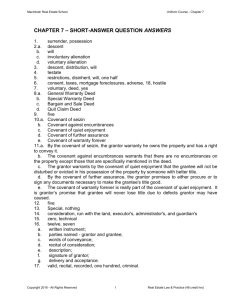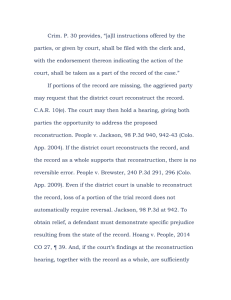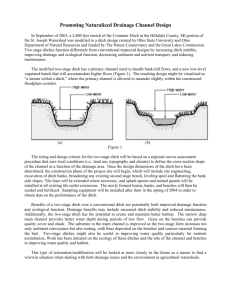the basics of water right conveyancing
advertisement
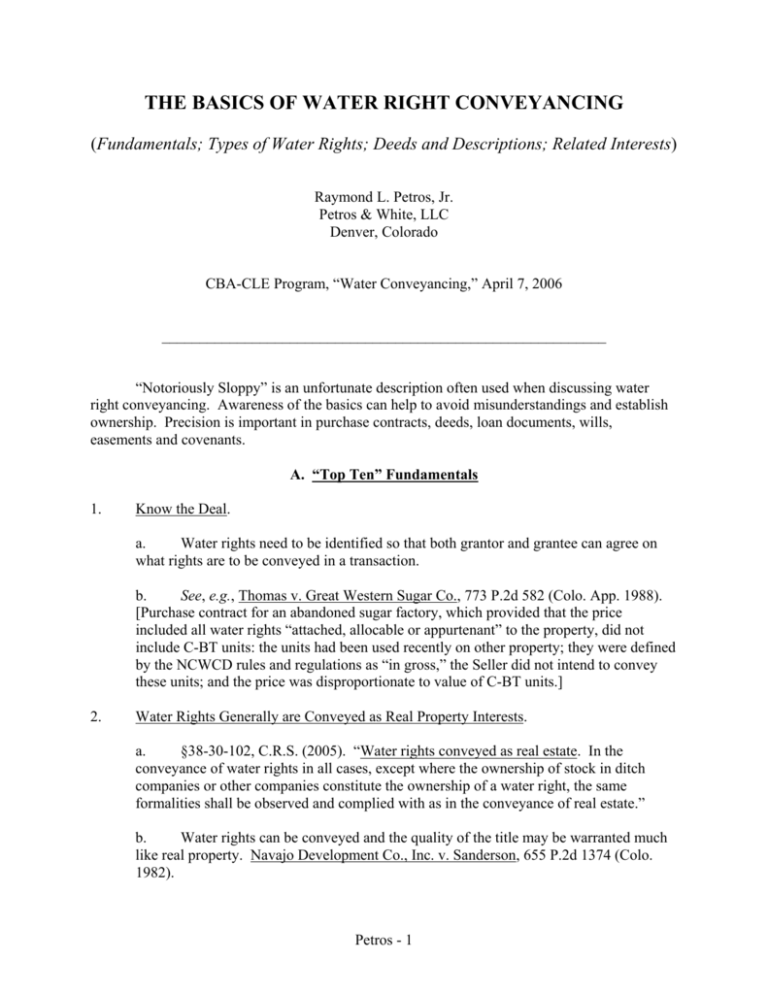
THE BASICS OF WATER RIGHT CONVEYANCING (Fundamentals; Types of Water Rights; Deeds and Descriptions; Related Interests) Raymond L. Petros, Jr. Petros & White, LLC Denver, Colorado CBA-CLE Program, “Water Conveyancing,” April 7, 2006 ___________________________________________________________ “Notoriously Sloppy” is an unfortunate description often used when discussing water right conveyancing. Awareness of the basics can help to avoid misunderstandings and establish ownership. Precision is important in purchase contracts, deeds, loan documents, wills, easements and covenants. A. “Top Ten” Fundamentals 1. Know the Deal. a. Water rights need to be identified so that both grantor and grantee can agree on what rights are to be conveyed in a transaction. b. See, e.g., Thomas v. Great Western Sugar Co., 773 P.2d 582 (Colo. App. 1988). [Purchase contract for an abandoned sugar factory, which provided that the price included all water rights “attached, allocable or appurtenant” to the property, did not include C-BT units: the units had been used recently on other property; they were defined by the NCWCD rules and regulations as “in gross,” the Seller did not intend to convey these units; and the price was disproportionate to value of C-BT units.] 2. Water Rights Generally are Conveyed as Real Property Interests. a. §38-30-102, C.R.S. (2005). “Water rights conveyed as real estate. In the conveyance of water rights in all cases, except where the ownership of stock in ditch companies or other companies constitute the ownership of a water right, the same formalities shall be observed and complied with as in the conveyance of real estate.” b. Water rights can be conveyed and the quality of the title may be warranted much like real property. Navajo Development Co., Inc. v. Sanderson, 655 P.2d 1374 (Colo. 1982). Petros - 1 3. Water Rights are Severable from the Land. a. Water may be bought and sold without regard to the real property over which it flows. Navajo Development, supra. at 1377. b. A water right is a real property interest separate and apart from the land on which it is used and may be conveyed or reserved separately from the land. Nielson v. Newmyer, 123 Colo. 189, 192-3, 228 P.2d 456, 458 (1951). 4. Water Right Decrees Do Not Establish Ownership. a. An adjudication of a priority for a water right confirms the pre-existence of a water right but does not grant or establish ownership of the water right in the claimant or applicant. See, Humphrey v. Southwestern Development Co., 734 P.2d 637 (Colo. 1987); and Cresson Consolidated Gold Mining and Milling Co. v. Whitten, 139 Colo. 273, 338 P.2d 278 (1959). 5. Title Insurance for Land Generally Excludes Water Rights. a. Standard land title insurance policies issued in real estate transactions do not insure against defects in title to associated water rights. The value of the water rights, however, might be included unwittingly in the amount of title insurance coverage, if based on the purchase price of the property. b. Water right title insurance has recently become available through Stewart Water Information, LLC. 6. Water Rights Might be Conveyed under the Appurtenance Clause of a Land Deed. a. If a deed is silent as to water rights, water rights nevertheless may be conveyed as an appurtenance, depending upon the intent of the parties (primarily the grantor) as determined from all the circumstances. Such circumstances may include the presumption that arises from whether the right is necessary to the beneficial use and enjoyment of the land. Kinoshita v. North Denver Bank, 31 Colo. App. 227, 501 P.2d 1337 (1972), aff’d, 181 Colo. 183, 508 P.2d 1264 (1973); Colorado v. Lionello, 157 Colo. 161, 401 P.2d 593 (1965); Bessemer Irrigating Ditch Co. v. Woolley, 32 Colo. 437, 76 P. 1053 (1904); Arnett v. Linhart, 21 Colo. 188, 40 P. 355 (1895). b. Lengthy usage on the land, plus mention of the water right in all subsequent conveyances, is enough to confirm that early silent deed implicitly passed the water right under the appurtenancy clause. Means v. Pratt, 138 Colo. 214, 331 P.2d 805 (1958). c. The fact that the land would be worth a small fraction of its value without the water right is indicative of intent to pass a water right. Hastings & Heyden Realty Co. v. Gest, 70 Colo. 278, 201 P. 37 (1921). Petros - 2 d. A sheriff’s deed following a foreclosure, without specific mention of water rights, does not pass title to water rights; however, if the intention of the parties was to include the water rights, then the judgment, sheriff’s sale and deed should be set aside. Travelers Insurance Co. v. Janitell Farms, Inc., 44 Colo. App. 34, 609 P.2d 1116 (1980). e. If an unambiguous will does not address the subject of whether water rights are transferred with the land, a devise of water rights may be implied by a court after examining all the surrounding facts and circumstances and evaluating whether the water rights are necessary for the beneficial use of the land. Such a rule, however, does not permit a court to violate the general rules of will construction by admitting extrinsic evidence of a testator’s intent regarding the water rights when the will is unambiguous. In re Estate of Tony Palaizzi Jr., 854 P.2d 1256 (Colo. 1993). f. Where a deed is silent, no presumption arises as to intent of parties in regard to transfer of tributary water rights. Bayou Land Co. v. Talley, 924 P.2d 136 (Colo. 1996). 7. Boilerplate Water Right Language Creates Presumption of Conveyance of “Appurtenant” Water Rights. a. General water right language in a deed conveys appurtenant water rights, but often creates ambiguity as to which rights are “appurtenant.” b. 8. Without specific description, record ownership is unclear. Explicit Listing of Water Rights Might Exclude Other Water Rights Erroneously. a. A specific designation of certain water rights can override a presumptive intent to convey any other water rights. Wanamaker Ditch Co. v. Crane, 132 Colo. 366, 288 P.2d 339 (1955). Expresso unius est exclusivo alterius. Where a deed clearly describes the water right to be conveyed, there is no room for the doctrine of implied grant. Davis v. Randall, 44 Colo. 488, 99 P. 322 (1908). See also, Thomas v. Great Western, supra. b. Where only a part of a right is described, such specific designation destroys any presumption of intent to convey the remainder. Nielson v. Newmyer, supra. 9. A Water Right Can be Lost in Part or in Whole by Abandonment. a. In contrast to land, a water right can be lost in whole or in part by an owner’s intent to abandon the right. Unexplained nonuse for an unreasonable period of time may prove an intent to abandon. Santa Fe Trail Ranches Prop. Owners Ass’n v. Simpson, 990 P.2d 46 (Colo. 1999). § 37-92-402, C.R.S. (2005). b. A chain of deeds may be evidence to rebut abandonment, but it is often not enough to rebut a presumption of intent to abandon from lengthy nonuse. See, e.g., Petros - 3 Haystack Ranch, LLC v. Fazzio, 997 P.2d 548 (Colo. 2000); Knapp v. Colorado River Water Conservation Dist., 131 Colo. 42, 279 P.2d 420 (1955). 10. Deeds to Overlying Land Presumptively Convey Unpermitted and Unadjudicated Nontributary Groundwater. a. Groundwater which is not tributary or hydrologically connected to a surface stream system is not subject to the Colorado constitutional doctrine of prior appropriation, but it is a public resource allocated by statute. State of Colorado v. Southwestern Colo. Water Conservancy District, 671 P.2d 1294 (Colo. 1983). Since 1973, nontributary groundwater is allocated based on the ownership of the overlying land to the landowner or to someone with the landowner’s consent or by sale to that party. § 37-90-137(4), C.R.S. (2005). b. The owner of the land does not own the nontributary groundwater but has an “inchoate right” to obtain a decree quantifying a right to the groundwater or to obtain a well permit from the State Engineer. c. Consent of the landowner to a municipal water provider’s use of the groundwater may be deemed to exist impliedly, pursuant to statute and by the municipality’s adoption of an implied consent ordinance or district resolution. §§ 37-90-137(4)(b)(II) and 37-90137(8), C.R.S. (2005). d. Colorado statutes recognize a special class of nontributary and not-nontributary groundwater in four aquifers within the area known as the Denver Basin along the Front Range, from Greeley to Colorado Springs, and from the foothills to Limon. § 37-90137(9), C.R.S. (2005). These aquifers are known as the Dawson, Denver, Arapahoe, and Laramie-Fox Hills aquifers, and in some places, these aquifers are divided into upper and lower aquifers. “Not-nontributary” groundwater is Denver Basin groundwater, the withdrawal of which will, within 100 years, deplete a natural stream at an annual rate greater than 0.1% of the annual rate of withdrawal. §37-90-103(10.7), C.R.S. (2005). e. For nontributary rights which existed prior to 1973, “pre-SB 213 Rights,” groundwater below a calculated circle of appropriation on overlying land around the well is considered to be appropriated by that well and unavailable for appropriation (since 1973) by other overlying landowners within the circle. f. In cases involving the conveyance of the inchoate (i.e., unappropriated and unadjudicated right) to develop nontributary and not-nontributary groundwater, the right is incident to land ownership so that the right is presumed to pass with the land in a deed, and encumbered by a deed of trust of the land, unless explicitly excepted or previously granted by deed or operation of statute. Bayou Land Co. v. Talley, supra.; and Chatfield E. Well Co. v. Chatfield E. Property Owner’s Ass’n, 956 P.2d 1260 (Colo. 1998). In Chatfield, the Court determined that a deed reservation of “nontributary” groundwater did not reserve “not-nontributary” water, even though that term was not in legislation at the Petros - 4 time of the reservation and the grantor intended to reserve the groundwater in the Arapahoe aquifer. g. “Better practice” is to memorialize intent to reserve groundwater by reservation of water rights in a deed; otherwise, the deed must be presumed to intend to transfer such right with the land. Bayou Land Co. v. Talley, supra. h. Decrees determining nontributary groundwater rights usually contain locations of proposed wells, but other wells may be added on the overlying land as required to withdraw the decreed amount of water. In the absence of explicit language, such proposed wellsites might give rise to a claim of implied wellsites when the groundwater rights are severed from the ownership of the land. B. Types of Water Rights 1. Appropriative Rights/Interests in Real Property. a. These usufructuary water rights involve “appropriations” of water, namely, diversion and beneficial use of water in priority. They include direct flow rights, storage rights, exchange rights, substitution rights, augmentation plans, temporary substitute supply plans, minimum streamflow rights for environmental purposes, recreational instream flow rights (“RICDs”), and tributary groundwater rights. The rights can be “absolute,” or “conditional” (i.e., not yet perfected by use). b. These rights are conveyed by deeds or leases, encumbered by deeds of trust, and perfected by recording in the same manner as real estate. §38-30-102, C.R.S. (2005). See Navajo Development Co., supra. at 1378. c. Water rights used on land (including mutual ditch company shares) are not taxed separately but their value is added to the real estate for tax purposes. Severed water rights might be taxed separately but this is not common. Colo. Const. art. X, §3(1)(d); §§39-3-104, 39-5-105 (1.1), C.R.S. (2005); Shaw v. Bond, 64 Colo. 366, 171 P. 1142 (Colo. 1918). See also, Beaty v. Bd. of County Comm’rs, 101 Colo. 346, 73 P.2d 982 (1937). 2. Mutual Ditch and Mutual Reservoir Companies/Hybrid of Real Property and Personal Property. a. A mutual ditch company is a nonprofit organization that is formed to provide common ownership and delivery of water in a ditch, reservoir, or other facility. See §§742-101, et seq. C.R.S. (2005). b. In Jacobucci v. District Court, 189 Colo. 330, 541 P.2d 667 (1975), the Colorado Supreme Court held that the owners of stock within a mutual ditch company are the equitable owners of the water rights even though held in the name of the company, and each shareholder owns the right to delivery of water in proportion to their stock Petros - 5 ownership. See generally, J. Kahn, Ownership of Mutual Ditch Company Assets, 20 Colo. Law No. 10, p. 2081 (1991). The shareholders may change the use of their pro rata share of the water rights outside the ditch, provided the remaining users are not injured. Wadsworth Ditch Co. v. Brown, 39 Colo. 57, 88 P. 1060 (1907). c. § 38-30-102, C.R.S. (2005) would appear to exclude the assignment of shares from the formalities associated with the conveyance of real estate, so that possession, assignment and reissuance of the stock certificate would perfect a conveyance of this personal property. Nevertheless, common practice is to convey stock by deed as well as by assignment, possession and reissuance as an interest in personal property. d. Articles of Incorporation and Bylaws might require approval of transfers, or rights of first refusal, or other restrictions. Ft. Lyon Canal Co. v. Catlin Canal Co., 642 P.2d 501 (1982). e. Mutual lateral ditch companies are formed to operate lateral ditches, off a main ditch of another entity. The lateral company might not own any water rights but might serve only to carry the water derived from the water rights of its shareholders. 3. Carrier Ditch Rights. a. A carrier ditch company owns the legal title to a decreed appropriation of water and facilities. Carrier ditches carry water for sale to consumers who have contracted with the company. Charges for water delivered by carrier ditches may be fixed by the board of county commissioners. The carrier ditch company is entitled to a reasonable return on its investment over and above costs. Nelson v. Lake Canal Co. of Colo., 644 P.2d 55, 5758 (Colo. App. 1981). b. Courts have recognized that carrier ditch companies are quasi-public entities with some fiduciary duties to their contracted consumers in setting rates and in permitting other consumers to exercise their constitutionally protected rights to continue to put water to a beneficial use on an annual basis. The terms of the contract defines most of the conditions of purchase and delivery of water. City of Westminster v. City of Broomfield, 769 P.2d 490 (Colo. 1989). c. Rights to receive water from a carrier ditch company are sometimes represented by shares and certificates. They often contain place of use restrictions and can be forfeited by nonpayment of charges. 4. Allotments. a. Water Conservancy District or other districts may allocate water from large projects by allotment contracts to water users. b. Typically, the contractual terms and regulations of the district limit the uses, places of use, and transferability of the water. For example, the Northern Colorado Petros - 6 Water Conservancy District requires approval of its Board for transfers of C-BT units, which process should be taken into account in setting deadlines under the purchase contract. Common practice is to convey such units by deed or deed of trust, subject to board approval. 5. Water Supply Contracts. a. Water supply contracts may have fixed or perpetual terms. Cherokee Water Dist. v. Colorado Springs, 184 Colo. 161, 519 P.2d 339 (1974); City of Colorado Springs v. Colorado City, 42 Colo. 75, 94 P. 316 (1908); see also, City and County of Denver v. Consolidated Ditches Co., 807 P.2d 23 (Colo. 1991). b. These supply contracts may require the provider’s approval of an assignment, change of use, or change in place of use. See East Ridge of Fort Collins, LLC v. The Larimer and Weld Irrigation Company, 109 P.3d 969 (2005). 6. Lease of Water Rights. a. A lease of specific water rights is the right to obtain the water yield from the exercise of these rights. Leases should be documented, recorded or perfected consistent with the type of underlying water right. 7. “Undivided Interests.” a. Water rights, ditches, and other water structures can be owned and operated jointly, either as tenants in common with undivided interests, or as owners with separate, divided interests. Care should be exercised when conveying these interests to specify the nature of the interest. See e.g., Denver v. Just, 175 Colo. 260, 487 P.2d 367 (1971). b. Owners of undivided interests in water rights or facilities can use their pro rata share of yield or capacity, together with the share of the remaining owners if not needed by them. Absent contract, such owners can transfer their water rights out of the common ditch (in effect “partition”), if no injury occurs to the remaining owners, and they are protected from of increased seepage, evaporation, or carriage leases. Hallett v. Carpenter, 37 Colo. 30, 86 P. 317 (1906). c. Where there has been a joint appropriation of a water right, but no tenancy in common of the right, each separate right can be transferred out of a common ditch. City of Telluride v. Davis, 33 Colo. 356, 80 P. 1051 (1905) [water in ditch divided in equal halves to the users]. d. As between owners of separate water rights diverted through the same ditch, the co-tenants of the ditch could remove their water rights from the ditch, without compensation for ditch loss or an obligation to continue rotation of the diversions, absent contractual provisions. Brighton Ditch Company v. City of Englewood, 124 Colo. 366, 237 P.2d 116 (1951). Petros - 7 e. A deed conveying water rights by “shares” to several parties was construed by the Colorado Supreme Court to convey separate ownership interests, not interests as tenants in common; the result was that some shares were deemed abandoned despite usage of the excess water by the other owners. Denver v. Just, supra. The Court reasoned that the nonuse by a share owner resulted in an abandonment of that part of the water right to the stream, and that the abandonment likely occurred before the running of the prescriptive use period for purposes of supporting the claims by the other owners. 8. Designated Basin Ground Water. A Designated Basin is an area which has been designated by the Colorado Ground Water Commission as an area where the ground water would not normally be available to and required for the fulfillment of decreed surface water rights, or ground water in areas not adjacent to a continuously flowing natural stream where ground water withdrawals have constituted the principal water usage for at lest fifteen (15) years prior to the creation of the designated basin. § 37-90-103 (6)(a), C.R.S. (2005). These designated basins are located on the eastern plains of Colorado. a. The Colorado Ground Water Commission, rather than the Water Courts, determines and administers the designated basin water rights pursuant to the Colorado Ground Water Management Act, §§ 37-90-101, et seq., C.R.S. (2005). The State Engineer assists the Ground Water Commission in the management and administration of the water within the designated basins. b. Within the designated basins, there may be created a local ground water management district which is empowered to regulate and administer water rights within the designated basin. § 37-90-118, et seq., C.R.S. (2005). Regulations may restrict use of water outside its boundaries. c. A water right within a designated basin is created by having the following documents on file with the State Engineer: i. A Well Permit issued by the State Engineer. ii. A Well Completion and Pump Installation Report or a Map and Statement for Water Well Filing filed within one year of the date the well permit was issued. iii. A Statement of Beneficial Use of Ground Water filed by the expiration date of the well permit if the well permit was issued before May 31, 1985, or within three years after the date the well permit was issued if the well permit was issued after May 31, 1985. iv. In addition to the foregoing documents, there should also be a final permit issued by the Ground Water Commission. § 37-90-108, C.R.S. (2005). Final permits take the place of water court decrees. Petros - 8 v. There may be water court decrees for water rights that predate formation of the designated basin. d. Designated basin ground water rights may be changed so long as the change of the water right will not result in material injury to vested water rights. § 37-90-111(1)(g), C.R.S. (2005). e. The appropriation of designated ground water and changes of designated ground water are governed by the Designated Basin Rules, 2 CCR 410-1. The Ground Water Commission is required to administer designated basin ground water rights on the basis of a “modified” prior appropriation doctrine to account for reasonable development of the finite resource while providing some protection to prior appropriators. f. The allocation of water within the designated basin is based on different factors for each designated basin. Most basins are considered “over appropriated” and no new water rights may be obtained in the basins. C. Conveyancing Instruments 1. Types of Deeds. Deeds of Water Rights that are real property interests can be made by: a. General Warranty Deed. Grantor covenants that at the time of the deed Grantor has title and authority to convey the property free and clear of all encumbrances, except for stated exceptions, and warrants possession of the property in Grantee, and will defend title to Grantee and Grantee’s heirs and assigns against all persons lawfully claiming the same. See § 38-30-113, C.R.S. (2005). b. Special Warranty Deed. Grantor covenants to warrant and defend title to Grantee and Grantee’s heirs, and assigns against all persons claiming to hold title by, through or under the Grantor. See § 38-30-115, C.R.S. (2005). c. Bargain and Sale Deed. Grantor makes no covenants of warranty but the deed will pass after-acquired title of the Grantor. d. Quitclaim Deed. Grantor makes no warranties of title and the deed only conveys whatever interest the Grantor has at the time of the deed. See § 38-30-116, C.R.S. (2005). 2. Meaning of Title Warranties. There is a reluctance to convey water rights by a general warranty deed because of sloppy conveyancing in the chain of title and because of uncertainty as to what warranties of title mean in the context of water rights (e.g., effects of nonuse, relative priorities, effect of injury by other water rights). Some of these uncertainties have been allayed by the Court’s decision in Navajo Development, supra. The court held that it was not a breach of title warranty under a Warranty Deed for a Grantor to refuse to defend the water right against a claim for reserved water rights by the U.S. Government which could pre-date the priority of the water right and reduce its value. The Court reasoned: Petros - 9 “[T]o view a water right as a fixed, tangible amount of water is to misunderstand the doctrine of appropriation. . . . Any warranties of title or other covenants attached to the conveyance of a water right must be in harmony with these underlying realities of the nature of a water right in Colorado. **** Navajo’s argument, therefore that the federal reserve water rights impair its priority by potentially diminishing the amount of water available under the conveyed water rights causing a breach of the covenants of seizin and freedom from encumbrances is erroneous. . . . Navajo’s priority is not affected at all. Federal reserve rights neither defeat Navajo’s title to water rights nor breach the covenants of quiet enjoyment and warranty of seizin. **** The covenants only guarantee that Water Right No. 310 is a vested priority of use not subject to defeat by persons seeking the same priority. No one can covenant that the amount of water available under a water right will maintain the same flow year in and year out and will not be diminished. . . . A covenant of title does not extend [to] the amount of water available for appropriation. . . .” Id. at 1378-1380. 3. Practice Pointers. a. Consider using the statutory approved short-form deeds. b. Consider using a “Deed and Assignment” for mutual ditch company shares. See Attachment B, as an example. c. Consider the use of a specific covenant in the deed which states that the Grantor has not intended to abandon the water d. Consider the use of explicit limits on warranties, such as Grantor makes no warranties or representations as to the effect on the water right resulting from its historical use or any nonuse, as to its relative priority to other water rights, as to injury by other water rights, or as to its suitability for Grantee’s use. e. Sample water right descriptions are attached hereto as Attachment A. f. Consider recording water decrees in the county real property records for crossreferencing in deeds, and to preserve the memory of the decrees. Recording of decrees was recommended by the Court in Davis v. Hurt, 81 Colo. 10, 253 P. 394 (1927). Petros - 10 4. Change of Ownership Notices. a. Upon the sale or transfer of a conditional water right, a notice of transfer must be filed with the Water Court. See Uniform Local Rules for all State Water Court Divisions, Rule 9. b. A Change of Ownership statement should be filed for well permits in the State Engineer’s office. c. A Motion for Substitution of Parties should be filed in the water court in pending cases or in cases with decrees with retained jurisdiction. 5. Water Rights in Conservation Easements. Colorado’s conservation easement statute expressly allows the inclusion of water rights in a land conservation easement. §38-30.5-102, C.R.S. (2005). The statute does not allow the creation of an easement solely on water rights; rather, only those water rights can be included that are used on the land or water area subject to a conservation easement. Water rights and their use should be explicitly included and described in the conservation instrument. Attachment C is a copy of model language recommended by the Colorado Water Trust for including water rights in conservation easements. D. Checklist of Other Property Related to Water Rights 1. Water in Storage. After diversion, water becomes the personal property of the appropriator. See Brighton Ditch Co, supra. Care should be taken to reach agreement on the disposition of this water between the time of the purchase contract and closing. 2. Structures. Ditches, lateral ditches, tail ditches, headgates, measuring devices, wells, pumps, pipelines, utilities, reservoirs, ponds, livestock tanks, irrigation sprinklers and pipes, improved springs, infiltration galleries. . . . 3. Easements/ROWS’s in Fee. Necessary for structures, access, utilities, operation and maintenance, replacement, recharge. . . . a. Relocation of a ditch requires consent of the ditch owner, or a declaratory judgment that the relocation will not impair the ditch or increase its costs. Roaring Fork Club, L.P. v. St. Jude’s Co., 36 P.3d 1229 (Colo. 2001). b. Water right owners may employ natural underground formations below the properties of others for the placement and carriage of appropriated water and for artificial recharge. See Bd. of County Comm’rs v. Park County Sportsmen’s Ranch, LLP, 45 P.3d 693 (Colo. 2002). 4. Dry-Up Covenants and other Land Restrictions. Often, to transfer an irrigation right off a piece of property, that property must no longer be irrigated with the remaining water rights. A water change decree might also require revegetation. Care should be taken to implement the terms of a water decree with enforceable covenants running with the land and enforceable by the Petros - 11 water right owner. The rights and obligations of these covenants and restrictions also need to be conveyed to successor parties. 5. Documents. Prior deeds; abstracts of title on the land (a good reference tool for title opinions); prior water right title opinions or title policies; engineering reports; diversion records; files. . . . In Santa Fe Trout Ranches v. Simpson, 990 P.2d 46, 51 (Colo. 1999), the Court, when finding abandonment of certain water rights, noted that no explanation was given why the former owner’s diversion records were not obtained by the subsequent owner. 6. Governmental Approvals and Permits. Well permits; SEO and other reservoir design approvals and inspection reports; U.S. Army Corps of Engineer 404 permits for diversion and discharge structures; land use approvals, including “HB 1041” county permits for domestic water systems and municipal and industrial projects. . . . References 1. ACQUIRING, USING AND PROTECTING WATER IN COLORADO, by Trout, Witwer & Freeman, P.C.; Bradford Publishing Co. (2004), ISBN: 1-889726-98-0. 2. VRANESH’S COLORADO WATER LAW, updated by James N. Corbridge, Teresa A. Rice, Stuart B. Corbridge; University Press of Colorado (2001). 3. WATER RIGHTS HANDBOOK FOR COLORADO CONSERVATION PROFESSIONALS, prepared for the Colorado Water Trust, by Peter D. Nichols, Michael Browning, Kenneth R, Wright, Patricia K. Floyd, and Mark Weston; Bradford Publishing Co. (2005), ISBN: 1-932779-32-9. 4. “Transactions with Water Entities: Everybody Beware,” a written presentation given by Timothy R. Buchanan at the Lorman Education Services program, “Water Rights Sales and Transfers in Colorado,” March 3, 2006, Denver, CO. Petros - 12 Examples -- Water Right Descriptions Example 1 (Quit Claim Deed -- Introductory Language): Any and all water rights (adjudicated or unadjudicated), wells, well permits, ditches, ponds, reservoirs, water in storage, springs (developed and undeveloped), equipment, discharge conduits, and associated easements and rights-of-way appurtenant to the Property (as described on Exhibit __) and any and all “nontributary” and “not nontributary” ground water rights underlying the Property (these terms are currently defined in §§ 37-90-103(10.5) and 37-90-103(10.7), C.R.S. (2005), respectively) which attach to ownership of overlying land pursuant to the law and §37-90-137(4), C.R.S. (2005) including all Denver Basin Aquifers (including Dawson, Upper Dawson, Lower Dawson, Denver, Arapahoe, Upper Arapahoe, Lower Arapahoe, and Laramie-Fox Hills formations). Such interests (collectively, the “Water Rights”) include, but are not limited to: Example 2 (Quit Claim Deed -- Undecreed Denver Basin Groundwater): Any and all unappropriated “nontributary” and “not nontributary” ground water rights (these terms are currently defined in §§ 37-90-103(10.5) and 37-90-103(10.7), C.R.S. (2005), respectively) appurtenant to the Property (as described in Exhibit___) including those rights which attach to ownership of overlying land pursuant to the law and §37-90137(4), C.R.S. (2005) including all Denver Basin Aquifers (including Dawson, Upper Dawson, Lower Dawson, Denver, Arapahoe, Upper Arapahoe, Lower Arapahoe, and Laramie-Fox Hills formations), but not including the following rights and interests, which are reserved (or excepted): Example 3 (Quit Claim Deed -- Generic and Specific (I) All Inclusive): All water, water rights, ditches, ditch rights, springs, spring rights, storage rights, reservoirs, reservoir rights, wells, well permits, stock certificates, contract rights, water allotments, and other rights in and to the use of water, whether or not adjudicated, which are appurtenant to or used on or in connection with the Property described in Exhibit A, attached hereto and incorporated herein by this reference, including but not limited to the following: [insert description of water rights] Together with all associated structures for the diversion, conveyance, measurement, storage, or use of said water rights, and all easements, rights of way, licenses, permits, contract rights, and governmental approvals therefor or pertaining thereto (collectively, the “Subject Water Rights”). Petros A-1 Example 4 (Generic and Specific [2] -- All Inclusive Introduction) All water, water rights, ditches, ditch rights, springs, spring rights, wells, well rights, storage rights, reservoirs, reservoir rights, appropriative rights of exchange, plans for augmentation, substitute supply plans, rights to water represented by shares of stock in mutual ditch or reservoir companies, water allotment contracts, water supply agreements and leases, water taps, rights in tributary, nontributary, and not nontributary ground water, and other rights in and to the use of water, whether or not adjudicated, which now or at any time are or have been underlying, appurtenant to, or used on or in connection with the real property described in Exhibit A, attached hereto and incorporated herein by this reference, together with any and all rights, claims and entitlements associated with the historic beneficial use of said water rights, and all ditches, reservoirs, embankments, flumes, headgates, measuring devices, wells, pumps, motors, pipelines, utilities and other structures and devices used for or associated with the diversion, conveyance, measurement, storage or use of the foregoing water and water rights, and all easements, rights of way, licenses, use permits, well permits, and contract rights therefore or pertaining thereto, including but not limited to those described on Exhibit B, attached hereto and incorporated herein by this reference. Example 5 (Introduction for Specified Water Rights -- Short Version) The following water rights, together with all structures and equipment used for or associated with the diversion, conveyance, measurement, storage, or use of the water or water rights, and all water, easements, rights of way, licenses, permits, contract rights and governmental approvals pertaining thereto: Example 6 (Specific Surface Water Right -- Old Decree) An undivided interest equal to __ (__) c.f.s. out of the ____ (__) c.f.s. of the _______ Ditch, decreed on ______________, by the District Court, ______ County, Colorado, in Case No. __, as Priority No. __, Water District No. __, with an appropriation date of __________, for irrigation, from _____ River at a decreed location in the ____ ¼, Sec. ___, T___, R___, _________________ County, State of Colorado; together with an undivided _____ (__) interest in the ______ Ditch and associated structures, rights of way therefor, and rights of access to and from the _________ Ditch for operation and maintenance. Example 7 (Specific Ditch Right -- Post 1969 Decree) All rights and priorities in the ________ Ditch, decreed on _____________, by the District Court, Water Division ___, State of Colorado in Case No. ______, for ___ c.f.s., for uses, from ____________ River, with an appropriation date of ________, and with a decreed headgate location at ___________, in the ___ 1/4 , Sec. ___, T___, R___, _____________County, State of Colorado. Petros A-2 Example 8 (Wells -- Generic and Specific) All water wells and appurtenant pumps, equipment, and wellhouses, and all water monitoring and measurement wells and associated equipment, located on the land described in Exhibit C attached to this Special Warrant Deed, together with all water rights, well permits, easements, rights of way, and access and utility rights for such wells, including, but not limited to the following: a. _________Well, Permit No. ________, located in the ___ ¼ ___ ¼ of Sec. ____, T___, R___, ___ P.M., together with the rights to tributary groundwater decreed on [date] , as Well No. ___ in Case No. ____________, District Court, Water Division No. __, Colorado, with an appropriation date of [date] , for irrigation use, in the amount of 1100 g.p.m. Petros A-3 SPECIAL WARRANTY DEED AND ASSIGNMENT [Sample Form: Mutual Ditch Company Shares Conveyance] FOR TEN DOLLARS and other good and valuable consideration, the receipt and sufficiency of which are hereby acknowledged, _____________ (“Grantor”), hereby sells, grants, transfers, and assigns to _______________ (“Grantee”), whose address is ______________, ______ (#) shares of stock (the “Subject Shares”) in the ___________ Ditch Company (“Company”), which are represented by Certificate No. ____, (copy attached as Exhibit A) together with all associated water rights, rights for the use of water, and other rights represented by the Subject Shares and warrants title to the same against all persons claiming under Grantor. Grantor does hereby irrevocably constitute and appoint the Secretary of the Company to transfer said Subject Shares upon the books of the Association with full power of substitution in the premises. Said shares were formerly used on the parcel of land described on Exhibit B [possibly reference here or include dry-up covenant, if necessary]. EXECUTED as of this ___ day of ___________, 2006. GRANTOR __________________________________ STATE OF COLORADO COUNTY OF _________ ) ) ss. ) The foregoing Special Warranty Deed and Assignment was acknowledged before me this ___ day of _____________, 2006, by _______________. WITNESS my hand and official seal. My commission expires: ___________________________________ Notary Public ___________________ Petros B - 1 MODEL LANGUAGE REGARDING WATER RIGHTS FOR LAND CONSERVATION EASEMENTS THAT INCLUDE HISTORIC IRRIGATION WATER RIGHTS [Source: Water Rights Handbook for Colorado Conservation Professionals, prepared for the Colorado Water Trust, at pp 70-80; written by Peter D. Nichols, Michael F. Browning, Kenneth R. Wright, Patricia K. Floyd, and Mark S. Weston.] Section ___. Water Rights. A) Water Rights Included. The parties agree that it is appropriate to include certain water rights beneficially used on the Property [or whatever term is used to define the land that is subject to the conservation easement] in this Conservation Easement Deed [or whatever term is used for the easement document] (the “Water Rights”). The “Water Rights” consist of all of the Grantor’s right, title and interests in and to the water and water rights described on Exhibit __, [NOTE: ALTERNATIVE LANGUAGE FOR USE IN SUCH EXHIBIT ARE ATTACHED AND SHOULD BE ATTACHED AS AN EXHIBIT TO THE CONSERVATION EASEMENT DEED] together with all associated canals, ditches, laterals, headgates, springs, wells, ponds, reservoirs, water shares and stock certificates, water allotments, contracts, units, permits, easements and rights-of-way, and irrigation equipment. B) Permitted Water Uses. The parties agree that the Water Rights are hereby dedicated and restricted exclusively for conservation purposes, including, but not limited to, the Conservation Values of the Property, agricultural, wildlife habitat, horticultural, wetlands, recreational, forest or other uses consistent with the protection of open land, environmental quality or life-sustaining ecological diversity (the “Permitted Water Uses”). The Permitted Water Uses include, but are not limited to, the continuation of the recent historical use, and the Grantor shall have the paramount right to use and enjoy the Water Rights on the Property consistent with recent historical practices. Grantor shall have the right to maintain, repair, and if necessary, reconstruct or replace any existing structures or equipment associated with the Water Rights (such as ditches, wells, irrigation equipment, and reservoirs), unless the Conservation Values of the Property would be irreversibly damaged thereby, as determined by the Grantee in its sole judgment. C) Restrictions on Water Rights. The parties agree that the Grantor may not (i) change the Water Rights to or use the Water Rights for municipal, industrial, commercial or any other new uses, (ii) change the Water Rights for use other than on the Property, (iii) sell or lease the Water Rights, or encumber them separately from the Property or otherwise legally separate them from the Property, or (iv) change the points of diversion, or the type or the place of use within or without the Property, except after Grantor’s receipt of a written determination by Grantee that such changes are not inconsistent with the Permitted Uses and will not impair the Conservation Values of the Property. Petros C - 1 Grantor shall not construct, or permit others to construct, any new diversion, storage or other water structures upon the Property, shall not develop any conditional water rights for use on the Property, and shall not otherwise undertake any new development of water resources for use on the Property without the prior written approval of the Grantee. D) Protection of Water Rights. In order to preserve and protect the Conservation Values of the Property, the Grantor shall continue the recent historical use of the Water Rights on the Property consistent with the Conservation Values and shall not abandon or allow the abandonment of any of the Water Rights, by action or inaction. Grantor shall annually report to the Grantee the nature and extent of use of the Water Rights during the prior year, which report need not be in writing, but shall include copies of any reports submitted to the State or Division Engineer or the Water Commissioner. The Grantor shall provide the Grantee a copy of any written notice received by Grantor from any state water official concerning the use, or possible abandonment, of the Water Rights. If the Water Rights appear on the decennial abandonment list or the Grantee determines that the Water Rights are otherwise subject to a threat of abandonment, the Grantee shall give the Grantor written notice of such threat of abandonment. If, and only if, Grantor fails to cure the threat of abandonment within 90 days of receiving such notice from the Grantee, the Grantee shall, in addition to any other remedies available to the Grantee under this Conservation Easement Deed or law, have the right to, (i) enter upon the Property and undertake any and all actions reasonably necessary to continue the historical use of the Water Rights, (ii) seek removal of the Water Rights from the decennial abandonment list, (iii) seek to change the Water Rights to another Permitted Water Use, and/or (iv) sell or otherwise convey all or part of such Water Rights to the Colorado Water Conservation Board or other entity for the specific conservation purpose of protecting or enhancing instream flows and/or water levels in streams, rivers, lakes and/or reservoirs to preserve or improve the natural environment of such water body(s). Grantor agrees to cooperate in any manner necessary to accomplish the Grantee’s election, and authorizes and appoints Grantee as its agent and attorney-in-fact to file for and obtain any administrative or judicial approvals required to effectuate Grantee’s election. E) Optional provision for instream loans. Temporary Instream Flow Use of Water Rights. The parties recognize that adverse environmental conditions, such as drought, occur from time to time, and that such conditions may pose a greater threat to the environmental quality and life-sustaining ecological diversity of streams, rivers, lakes and reservoirs than to the Conservation Values of the Property. Therefore, the parties agree that the Grantor may enter into legally enforceable water leases, contracts, emergency water loans, or similar agreements for conservation purposes to temporarily increase instream flows and/or water levels in streams, rivers, lakes, and/or reservoirs to preserve the natural environment of such water body(s), provided that (i) the Grantee has given its prior written consent to such arrangements, and (ii) the Water Rights shall not be used for such Petros C - 2 uses more than three out of every 10 years without a written determination by the Grantee that such use would not jeopardize the long-term Conservation Values of the Property. F) Recording encumbrance on stock certificates. If the Water Rights include any shares in ditch or reservoir companies, the Grantor shall promptly submit the related stock certificate(s) to the appropriate ditch and reservoir company for inclusion of the following notation thereon: "These shares are subject to the terms and restrictions set forth in the Conservation Easement Deed from _______ to _________ recorded in the Real Property Records of ___________ County Colorado on __________, 20__ at Reception No. __________________." A copy of the re-issued stock certificate(s) shall be promptly provided by Grantor to Grantee. EXHIBIT __. WATER RIGHTS 1. [When the water rights to be included in the conservation easement can be described with specificity, include as much detail as possible, i.e., name of water right, source of water, amount, court and case number, date(s) of appropriation and date(s) of adjudication, well permit number(s), allotment contract(s), and/or certificate number(s) for shares in ditch and reservoir companies.] 2. [When the water rights to be included in the conservation easement cannot be described with specificity, but the intent of the parties is to include ALL of the water rights.] The “Water Rights” consist of all of the Grantor’s right, title and interests in any and all water and water rights of any kind or nature historically used on the Property, together with all canals, ditches, laterals, headgates, springs, ponds, reservoirs, water allotments, water shares and stock certificates, contracts, units, permits, wells, easements and rights of way, and irrigation equipment associated therewith. The Water Rights include surface water rights and groundwater rights (tributary, nontributary, not nontributary, and designated) whether decreed or undecreed. Petros C - 3
